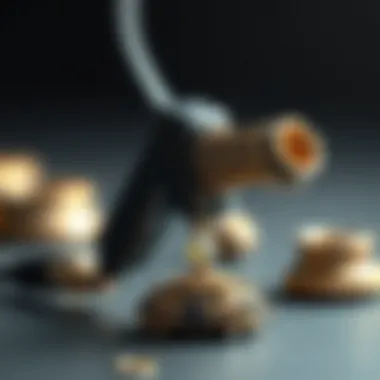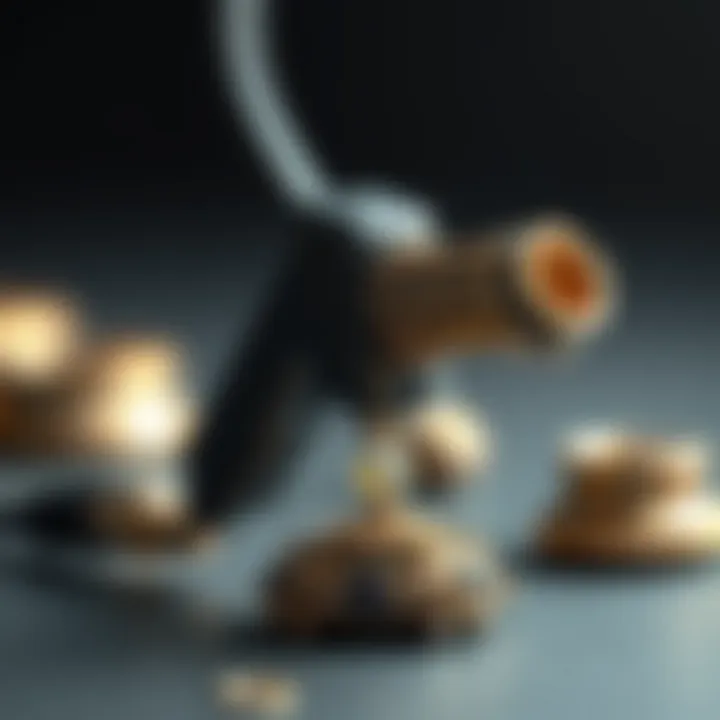Mastering Jewelry Repairs with a Soldering Gun


Intro
When it comes to jewelry repairs, the soldering gun is often underrated yet indispensable. Imagine needing to fix a delicate necklace or reattaching a gemstone to a beloved ring. A soldering gun can turn potential disasters into seamless repairs. This guide will delve into the world of soldering guns, focusing on their utility in jewelry crafting and repair. We'll also highlight effective techniques, necessary safety measures, and how to choose the right equipment for your specific needs, providing all the tools of the trade for both hobbyists and professionals alike.
Gemstone Overview
Definition of Gemstones
Gemstones, often considered nature’s artwork, are precious or semi-precious stones that are cut and polished to create beautiful objects, especially jewelry. These materials vary widely in terms of their properties like hardness, color, and clarity. They are not only used to enhance the aesthetic appeal of jewelry but also carry symbolic meanings in various cultures. A stone like diamond is known for its toughness, while emeralds are treasured for their vibrant green hue.
Classification of Gemstones
Gemstones can be classified in several ways, but one of the most common is by their mineral composition. The major categories include:
- Precious Gemstones: Diamonds, sapphires, rubies, and emeralds, valued for their rarity and beauty.
- Semi-Precious Gemstones: A variety including garnet, amethyst, and turquoise. These stones may be more abundant but can offer stunning colors and designs.
- Organic Gemstones: Pearls and amber fall into this category as they are derived from living organisms.
Characteristics
Some essential characteristics to consider when evaluating gemstones include:
- Hardness: Measured on the Mohs scale, which ranks minerals from 1 (talc) to 10 (diamond).
- Clarity: Refers to the absence of inclusions or blemishes within the stone.
- Color: The hue, tone, and saturation can drastically affect a gemstone's value.
- Cut: How well a gemstone has been shaped and polished influences light performance and symmetry.
It’s crucial for jewelers and enthusiasts to understand these factors when working with gemstones to ensure quality repairs and fittings.
The relationship between gemstone quality and soldering techniques is significant. Knowing the properties of each stone affects how a jeweler approaches repairs, particularly when using a soldering gun for delicate tasks.
In the sections that follow, we will dive deeper into the techniques and safety measures involved in using a soldering gun effectively for jewelry repairs, ensuring every piece can shine like new.
Prelude to Jewelry Repair
Jewelry is often more than just ornamental; it carries sentimental value that can span generations. When pieces break or wear down, the significance of their restoration becomes paramount. This article focuses on the art and science of jewelry repair, particularly through the use of a soldering gun, an underappreciated yet essential tool in any jeweler's toolkit.
The Importance of Jewelry Maintenance
Maintaining jewelry is akin to looking after an old friend; without care, what was once beautiful can become tarnished or broken. Regular maintenance ensures that pieces not only retain their luster but also function as intended. Beyond aesthetic appeal, jewelry may hold personal stories—wedding rings, family heirlooms, or gifts marking special occasions.
The act of repair, particularly with soldering, allows one to keep these stories alive. Just like a well-worn photo album, torn but cherished, repaired jewelry can continue to weave connections to our past, often becoming even more cherished through their imperfections. This underscores the importance of knowing how to effectively repair jewelry, ensuring it stands the test of time while preserving those meaningful attachments.
Common Jewelry Issues
Jewelry can face a myriad of challenges over time, often leading to the need for repairs. Here are a few common issues many encounter:
- Broken Chains: Links can become misaligned or completely severed, leaving necklaces and bracelets in disarray.
- Loose Stones: Settings can wear down, leading to stones becoming detached from their original mounts, risking loss.
- Worn Out Clasps: These tiny closures are vital for keeping jewelry secure, and their malfunction can render a piece practically useless.
- Tarnishing and Discoloration: Metal can lose its shine or change color due to exposure to air and moisture, making cleaning necessary.
Each of these issues brings not just technical challenges but emotional weight. An understanding of how to repair these common problems, particularly through methods like soldering, can empower individuals to breathe new life into beloved pieces. It transforms the setback of a broken item into an opportunity for a restoration that celebrates the history bound to that piece.
Essentially, taking the time to address these common issues can keep jewelry in working condition, allowing it to be enjoyed for many years to come. By honing the skills necessary for such repairs, one can become intimately involved in the pieces they own, effectively intertwining the art of craft with personal history.
Understanding Soldering
Soldering is fundamentally crucial to jewelry repairs as it creates a strong bond between metal pieces. This artful process allows jewelers to restore broken items, attach components, or create the intricate designs that many enthusiasts desire. A solid understanding of soldering techniques and the materials involved ensures high-quality repairs that stand the test of time. Equipping oneself with this knowledge not only enhances one’s skills but also boosts confidence in handling various jewelry issues.
Unlike welding, which melts the base metals, soldering utilizes a filler metal that has a lower melting point. Therefore, it is imperative to grasp how this method plays a role in the types of metals used in jewelry, including gold, silver, and copper. Knowing the differences and compatibility of these materials can make a world of difference in achieving successful results.
Furthermore, proficiency in soldering opens doors to innovation in design and creativity. Jewelers can explore new styles and transformations in existing pieces by effectively merging various elements. Therefore, a solid foundation in soldering is not just about repair, but is also a pathway to artistic expression.


What Is Soldering?
Soldering is the technique of joining two or more pieces of metal together by melting a filler material, known as solder, which flows into the joint between the workpieces. As it cools, the solder solidifies, forming a strong connection. The process is often likened to gluing but requires heat instead of adhesive.
To break it down into simpler terms, think of soldering as pouring a thin, molten layer between two metal parts. After cooling, this layer acts as a bridge, holding the parts tightly together. Jewelers use different types of solder, typically categorized by their melting points, and selecting the right one is key to the integrity of the finished piece.
In the case of jewelry, solder types can vary based on the metal being worked on, enabling versatility for repairs or new creations. For instance, yellow gold, white gold, and silver each have specific solder grades suited to their characteristics. Thus, the knowledge of soldering is indispensable for anyone involved in jewelry making or repairs.
Types of Soldering Processes
There are several soldering processes used in the industry, each serving distinct needs and situations.
- Soft Soldering: Commonly used for low-heat applications, soft soldering usually employs tin-based solder. This method is popular for delicate repairs and joins where strength isn’t the primary concern.
- Hard Soldering: Perfect for jewelry, this process involves higher temperatures and metals like silver or gold solder. This type ensures a robust bond and is preferred for heavier or critical structural repairs.
- Silver Soldering: In this process, more specialized silver solders are used. Depending on the chosen solder, different temperature ranges can greatly affect the outcome; thus, precision is vital.
- Brazing: When joining dissimilar metals or when higher strength is required, brazing comes into play. This method uses a filler metal that melts at higher temperatures, making it suitable for more severe applications.
- Laser Soldering: An innovative technique that employs a laser to heat the metal and solder. This is gaining traction in modern workshops due to its precision and minimal heat impact on surrounding materials.
Understanding these various types of soldering processes equips jewelers with the fundamental skills needed to assess each project accurately. It can make a significant difference between a successful repair and a frustrating failure, emphasizing the importance of mastering these techniques.
The Soldering Gun: A Key Tool
When it comes to jewelry repairs, the soldering gun stands out as an indispensable companion for both novices and seasoned artisans alike. Understanding its components and types enhances one’s ability to execute precise and durable repairs on delicate items, be it a cherished heirloom or a recent acquisition.
Components of a Soldering Gun
A typical soldering gun consists of several key components that work in harmony to deliver the right heat and precision. At its core, there's a heating element responsible for melting the solder. This is usually encased in a nozzle that directs the heat to a specific area. Many models come equipped with a trigger that controls the power, allowing for quick activation and deactivation. The handle is designed for comfort and grip, reducing fatigue during prolonged use. Additionally, some soldering guns include built-in stands to keep the tool steady and safe when not in use.
The wiring and insulation within the gun ensure that the heat is effectively contained, minimizing the risk of burns to the user. Understanding these components equips the repairer to make informed decisions when selecting a soldering gun suited for their specific needs in jewelry making.
Types of Soldering Guns
When diving into the realm of soldering guns, it's essential to be familiar with the three main types available, each catering to different preferences and requirements in jewelry repairs.
Electric Soldering Guns
Electric soldering guns are perhaps the most common type found in workshops. Their primary attribute is the quick heat-up time, enabling immediate use, which is a blessing during intricate repairs. Often, these guns boast a variety of wattage options, allowing users to adjust power based on the material's sensitivity.
A standout feature of electric soldering guns is the ability to maintain consistent temperature, which is paramount in creating strong and lasting joints. However, one should be cautious, as overheating can lead to damage of precious stones or metals if not closely monitored.
Battery-Powered Soldering Guns
For those who prioritize mobility and convenience, battery-powered soldering guns come as a breath of fresh air. Their portability means repairs can be conducted anywhere, without the need for an electrical outlet. This makes them a favored choice for jewelers who frequently attend craft fairs or outdoor events.
The key characteristic of battery-powered guns is their lightweight design, which complements the needs of those who may have long repair sessions. Though convenient, their battery life can limit usage over extended periods, necessitating periodic charging to maintain functionality.
Adjustable Temperature Soldering Guns
Adjustable temperature soldering guns offer a level of versatility that appeals to those who work with a wide array of materials. By allowing the user to set the heat according to the specific job at hand, these guns enable greater control over the soldering process.
A prominent feature of adjustable temperature guns is the variable wattage settings, which can range from low to high, depending on the task. This adaptability makes them particularly beneficial for intricate designs or sensitive components, ensuring one can avoid the pitfalls of overheating. On the downside, mastering these settings may require some experience, but the payoff is often worth the investment in time and practice.
Understanding the features and functions of different soldering guns is crucial for successful jewelry repairs, as it allows for tailored applications based on unique materials.
Selecting the Right Soldering Gun
Choosing the appropriate soldering gun for jewelry repair is crucial. With countless options available in the market, selecting the right tool can significantly impact the quality of your repairs as well as your efficiency. An ill-suited soldering gun can lead to damaged materials, poor solder joints, and even safety issues. Therefore, understanding the unique features of various soldering guns is essential for achieving optimal results. Enabling the creation of durable, beautiful repairs, the right soldering gun stands as a cornerstone for both novice and seasoned jewelers.
Factors to Consider
Material Compatibility


Material compatibility refers to how well a soldering gun works with the specific metals or materials used in jewelry making. Different types of metals, such as gold, silver, or copper, require varying heat levels and solder types. Understanding this aspect can help in selecting a soldering gun that can effectively bond these materials without causing them to warp or burn.
A key characteristic here is the type of solder wire you plan to use. For example, if you're working primarily with sterling silver, lead-free solder would be a fitting choice, as it minimizes toxic exposure while still offering strong bonds. The beneficial nature of material compatibility underlines the fact that a soldering gun capable of handling different materials can offer versatility to your repair capabilities. However, using a soldering gun not suited for a specific type of metal can lead to poor adhesion and potential damage.
Power Requirements
Power requirements pertain to the wattage of the soldering gun and its capability to reach and maintain the necessary temperatures for soldering various materials. A higher wattage generally means quicker heating times and more consistent temperatures, which is vital for effective soldering. A soldering gun with sufficient power can also sustain heat when more demanding jobs arise, ensuring that you don’t lose momentum during intricate tasks.
When examining power requirements, a key characteristic is the wattage rating. Often, a soldering gun rated between 30-80 watts is sufficient for most jewelry tasks. This is a beneficial choice as it allows for significantly improved melting capacity of solder, making it easier to work on intricate details and layered materials. The drawback comes when too much power is used on a delicate piece—localized overheating can result in irreversible damage.
Temperature Control
Temperature control is another essential feature when selecting a soldering gun. This aspect allows the user to adjust the heat settings based on the requirements of the material being soldered, promoting precision and reducing the risk of damaging the piece. Many soldering guns come with adjustable temperature settings, providing greater freedom to adapt to specific repairs.
The key characteristic of good temperature control is the range it offers. A soldering gun that can maintain a wide temperature range, often between 350°F and 850°F, is particularly favored among jewelers. This capability enables beneficial variations in heat application based on processes and materials. Conversely, not having adequate temperature control might lead to solder problems, with joints that are too weak or, worse, burnt and unsightly.
Understanding these factors when choosing a soldering gun is vital for a successful jewelry repair experience. Each feature contributes significantly to the quality of your work, enhancing both efficiency and the final aesthetic of the repaired piece.
By carefully considering these elements—material compatibility, power requirements, and temperature control—you can find a soldering gun that suits your specific needs and elevates your jewelry repair efforts.
Essential Soldering Techniques for Jewelry
Soldering is an art that needs both skill and patience, especially when it comes to jewelry repair. Mastering essential soldering techniques can differentiate between a successful repair and a regrettable mishap. By effectively understanding these techniques, you can preserve the integrity of precious pieces, ensuring they remain not only functional but beautiful.
Among the many elements to consider, preparation, execution, and finishing touches are paramount. Each step has its own significance and methods aimed at achieving excellence in repairs. Let’s break down these crucial techniques into manageable pieces that are easy to understand.
Preparation of Materials
Before you even think about heating that soldering gun, preparation is where the magic begins. This step involves gathering all necessary tools and ensuring materials are ready for the job. The first thing you need to do is clean the pieces; any grease or dirt can cause solder not to adhere correctly.
Furthermore, it helps to have a good workspace. A flat, sturdy surface with proper lighting allows you to see your materials clearly. Keeping things organized can save you from scrambling around looking for tools when you should be soldering.
- Gathering Tools: Make sure your soldering gun is in good working condition, along with flux, solder material, and a pair of tweezers.
- Organize Workspace: Arranging materials beforehand helps in a smooth and efficient workflow.
By taking these preparatory steps seriously, you lay a strong foundation for the subsequent soldering tasks.
Basic Soldering Steps
Once you’re all set, it's time to get down to the basics. Start by turning on the soldering gun and allowing it to reach the appropriate temperature. The soldering process itself is essentially about heat management and precision.
- Apply Flux: It serves as a cleaning agent to help solder flow smoothly. Apply a small amount to the area needing repair before heating.
- Heat the Junction: Position the soldering gun tip over the point of connection without applying solder just yet. Wait for a moment until the metal begins to glow a bit.
- Introduce Solder: Once the metal is sufficiently heated, gently touch the solder against the junction. If the temperature is right, the solder will melt and seep into the gap.
- Allow to Cool: After achieving an adequate bond, take the soldering gun away and let the piece cool naturally. Do not rush this process, as it could lead to weak joints.
Executing these steps can vastly improve the quality of your repairs and give you a sense of accomplishment.
Finishing Techniques
Once you’ve completed the soldering, turning your attention to the finishing techniques is vital to enhancing the appearance and overall quality of the jewelry. It is like frosting on a cake—necessary for a polished final product.
Polishing
Polishing is one of those steps often overlooked but is actually crucial. It removes any oxidation that occurs during soldering and also gives the piece a lustrous shine. You can use different polishing compounds depending on the metal you’re working with.
- A key characteristic of polishing is versatility; it can be used on various materials like gold, silver, and even some types of gemstones, restoring their original beauty.
- However, it’s worth noting that over-polishing can lead to material thinning, so exercise caution.
Cleaning


Cleaning the piece after soldering is equally paramount. Just like a good chef wouldn’t serve a dish without proper hygiene, your jewelry deserves a thorough clean. It helps remove residue from flux and any accidental grime introduced during the repair process.
- The straightforward aspect of cleaning is its simplicity. Use a gentle soap solution or specialized jewelry cleaning solution tailored to the type of metal used.
- Nonetheless, some delicate gemstones might require specific care instructions, so make sure to consult manufacturer guidelines where necessary.
Incorporating these finishing techniques not only enhances the appearance but also ensures the longevity of your jewelry, allowing it to be admired for years to come.
Safety Considerations
When engaging in jewelry repairs, particularly with tools like soldering guns, prioritizing safety is not just smart; it's essential. Jewelry repair involves high temperatures and sometimes toxic materials, making an awareness of safety measures critical in ensuring a safe working environment. By adhering to specific safety guidelines, you can protect yourself or others who may be in your workspace and minimize the risk of accidents.
Personal Protective Equipment
In any line of craftsmanship, personal protective equipment (PPE) is your first line of defense. For jewelry repair using a soldering gun, integrating the appropriate gear into your routine is non-negotiable. Here’s a breakdown of the most pivotal pieces of PPE:
- Safety Glasses: Melting solder can easily splatter or fume. Protect your eyes with durable safety glasses that can withstand high temperatures and provide a clear line of sight.
- Heat-Resistant Gloves: Investing in quality heat-resistant gloves can safeguard your hands from burns and allow for better grip when maneuvering hot tools or metal pieces.
- Respirator Mask: Inhaling fumes from soldering can pose health risks. A good respirator mask filters out harmful substances and keeps your lungs healthy while you work.
In addition, consider wearing long sleeves and an apron made of a fire-resistant material to shield your skin from any accidental splashes or burns.
Handling the Soldering Gun Safely
Proper handling of the soldering gun is the cornerstone of workplace safety. Mishandling can lead to personal injury or damage to your materials. Keep these best practices in mind when using a soldering gun:
- Read the Manual: Each soldering gun operates differently. Familiarize yourself with your specific model’s instructions before use.
- Secure Your Workspace: Ensure your work area is clean and clutter-free. Avoid having flammable materials nearby as the heat can ignite them easily.
- Always Unplug When Not in Use: This may seem basic, but it’s often overlooked. Unplugging your soldering gun when taking breaks or switching tasks can prevent accidental activation.
- Use Tools for Handling Hot Items: Instead of using your bare hands to touch hot metals or tools, specialty pliers or tweezers can provide a safer option. This often goes a long way in protecting your skin from burns.
"Safety isn't expensive. It's priceless."
By employing a combination of personal protective equipment and following safe handling protocols, you can create a safer environment that enhances your comfort and focus while you engage in intricate jewelry repairs. The importance of these safety considerations cannot be understated; they establish the groundwork for successful and secure crafting.
Common Misconceptions About Soldering Guns
When delving into the realm of jewelry repair, an understanding of the tools at one’s disposal is paramount. Among those tools, the soldering gun often garners a myriad of misconceptions, leading many to underestimate its potential in jewelry crafting. Addressing these misconceptions is crucial for both novices and seasoned artisans who wish to expand their capabilities efficiently.
Soldering Guns vs. Traditional Soldering Methods
Many jewelry makers hold a steadfast belief that traditional soldering methods prevail over the use of soldering guns. It's often thought that the delicate nature of jewelry demands precision that only a soldering iron can provide. However, this is not entirely correct. While soldering irons do have their place, soldering guns offer speed and efficiency, essential in today’s fast-paced environments.
- Speed of Operation: One primary advantage of soldering guns is their ability to heat up quickly and allow for immediate solder application. This is beneficial when dealing with intricate pieces that require swift repairs.
- Adjustable Heat Settings: A common misconception is that heat cannot be regulated with soldering guns. In fact, many modern soldering guns come with adjustable heat settings. This flexibility allows a jeweler to match the temperature according to the material being worked on, thus avoiding damage and ensuring precision.
Furthermore, soldering guns can handle different types of solders, from lead-free to silver solder, making them versatile for various jewelry materials. Shifting from rigid beliefs about traditional methods can open new avenues for creativity and efficiency.
Heat Settings and Material Compatibility
The realm of soldering is as much about understanding material compatibility as it is about applying heat. A common misconception is that every soldering gun is created equal when it comes to handling various materials. Not all soldering guns are suited to the same types of metal, and this can lead to detrimental effects if one is not careful about material compatibility.
- Material Specifications: It’s vital to be aware of which soldering gun can work with precious metals like gold or silver compared to base metals. For instance, some guns may provide too much heat for soft metals, resulting in burns or undesired results.
- Optimal Heat Settings: Different materials require different heat settings to achieve a proper bond without damaging the piece. Gold solder, for example, might work well at a lower temperature compared to aluminum solder, which requires a more intense heat. This knowledge is crucial to ensure beautiful, durable repairs.
"Knowledge is the first step towards mastery; dispelling misconceptions opens the door to creativity and innovation in jewelry repair."
For further insights on soldering techniques and material handling, visit Wikipedia or explore community discussions on Reddit.
The End
In wrapping up our discussion on the use of soldering guns for jewelry repairs, it’s vital to appreciate how this tool streamlines the repair process and enhances both functionality and aesthetics of various jewelry pieces. Soldering, when done right, can restore integrity to broken items, maintaining their sentimental value or even improving their appearance.
Summarizing the Soldering Process
The soldering process itself involves several key steps that ensure a durable and clean bond between metal pieces. Initially, proper preparation is necessary. This includes cleaning the surfaces that will be joined to remove any oxidation or dirt. Next, applying flux helps to promote an even flow of solder when heat is introduced. The actual soldering requires steady hands and the right equipment, particularly a soldering gun with precise temperature settings suited to the metals being used. After soldering, the workpiece may need some post-repair finishing, like polishing or even reapplying patina, to achieve a seamless finish.
Future Innovations in Jewelry Repair Technology
Looking ahead, we can anticipate advancements in jewelry repair technology that may revolutionize the way we approach soldering. For instance, innovations such as laser soldering offer impressive precision and reduce heat exposure, minimizing the risk of damaging surrounding materials. Moreover, next-gen soldering guns that utilize smart technology could implement temperature sensors that adjust heat in real-time, accommodating different materials automatically. Collectors and designers can leverage these innovations to not only ensure repairs are done effectively but also to push the boundaries of what can be achieved in custom jewelry design.
Ultimately, whether you’re a gemstone enthusiast eager to learn or a seasoned jewelry designer, understanding and mastering soldering techniques will benefit your craftsmanship, maintaining the beauty and longevity of cherished pieces.



